Fair Value Measurement of Assets: IFRS 13 and Wesfarmers
VerifiedAdded on 2020/03/02
|10
|2828
|205
Report
AI Summary
This report provides an executive summary on the significance of fair value measurement under IFRS 13, focusing on its application in business entities. It delves into the definition of fair value as per IASB, emphasizing the valuation techniques employed to determine the fair value of assets and liabilities, with a particular focus on non-current assets. The report highlights the challenges businesses encounter when implementing fair value measurement, particularly in the context of assets not actively traded. It uses Wesfarmers Limited as a case study, examining the types of non-current assets held by the company, and the problems faced in assessing their fair value. Furthermore, the report critically analyzes the practicality of the IASB's approach to fair value measurement for companies holding non-current assets that lack broad and deep markets, offering insights into the complexities and implications of IFRS 13.
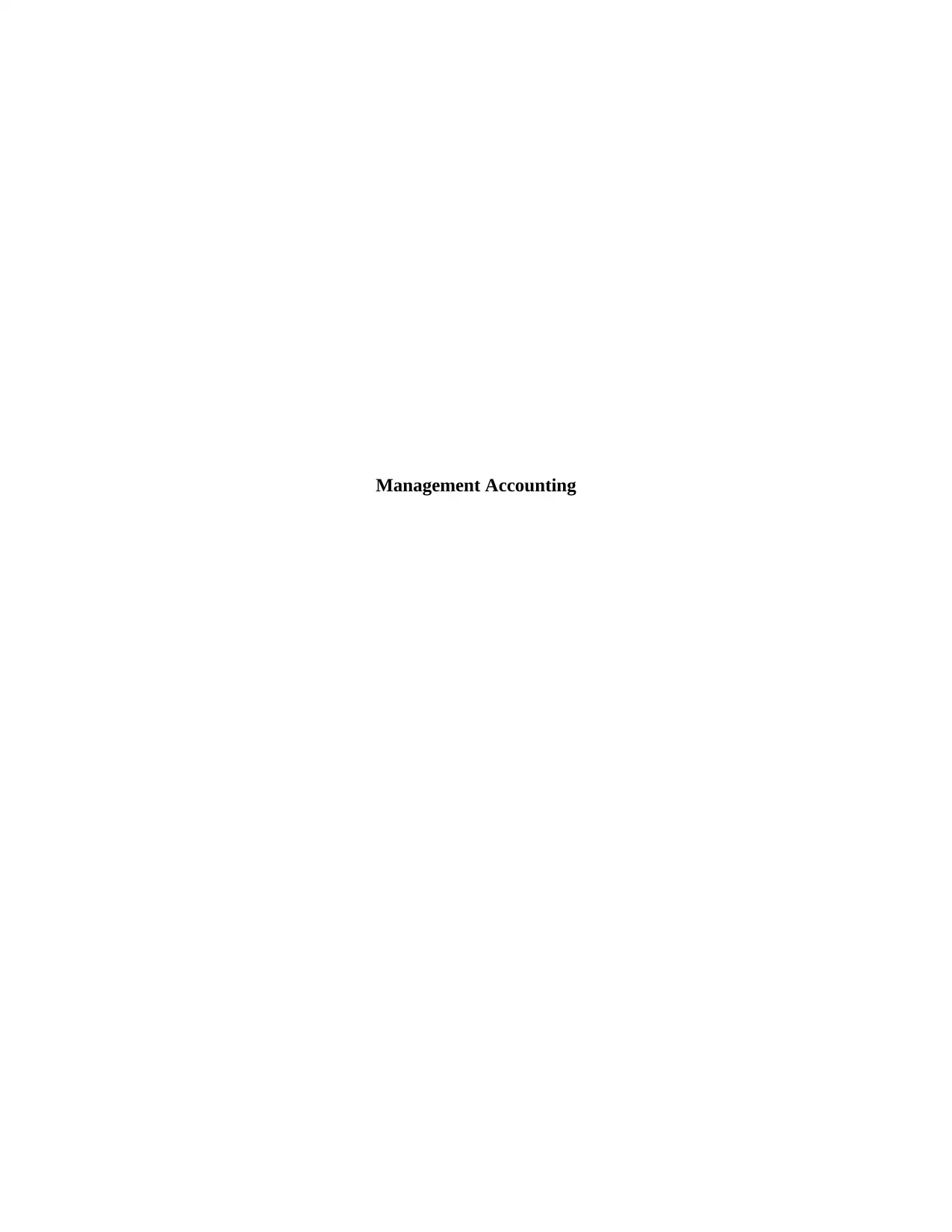
Management Accounting
Paraphrase This Document
Need a fresh take? Get an instant paraphrase of this document with our AI Paraphraser
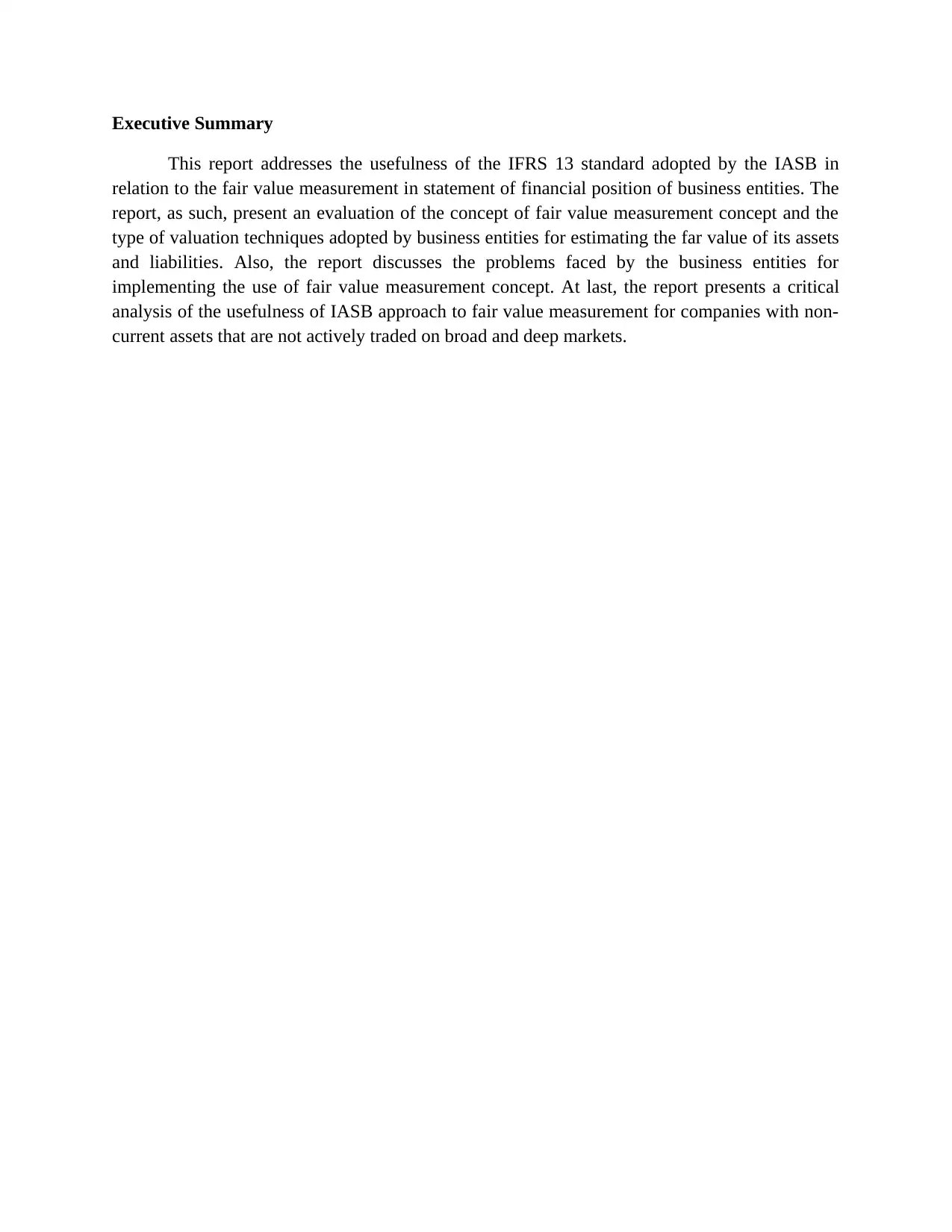
Executive Summary
This report addresses the usefulness of the IFRS 13 standard adopted by the IASB in
relation to the fair value measurement in statement of financial position of business entities. The
report, as such, present an evaluation of the concept of fair value measurement concept and the
type of valuation techniques adopted by business entities for estimating the far value of its assets
and liabilities. Also, the report discusses the problems faced by the business entities for
implementing the use of fair value measurement concept. At last, the report presents a critical
analysis of the usefulness of IASB approach to fair value measurement for companies with non-
current assets that are not actively traded on broad and deep markets.
This report addresses the usefulness of the IFRS 13 standard adopted by the IASB in
relation to the fair value measurement in statement of financial position of business entities. The
report, as such, present an evaluation of the concept of fair value measurement concept and the
type of valuation techniques adopted by business entities for estimating the far value of its assets
and liabilities. Also, the report discusses the problems faced by the business entities for
implementing the use of fair value measurement concept. At last, the report presents a critical
analysis of the usefulness of IASB approach to fair value measurement for companies with non-
current assets that are not actively traded on broad and deep markets.
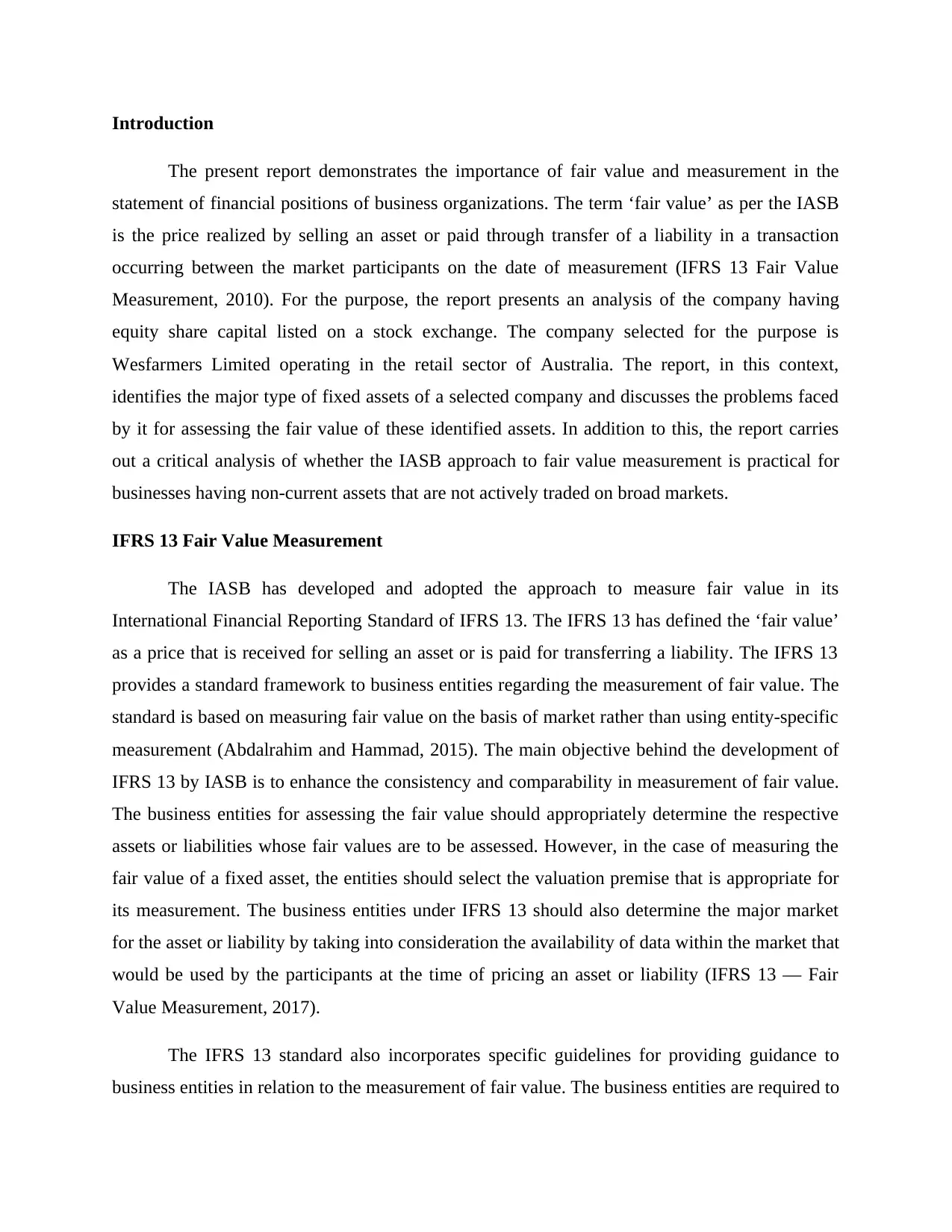
Introduction
The present report demonstrates the importance of fair value and measurement in the
statement of financial positions of business organizations. The term ‘fair value’ as per the IASB
is the price realized by selling an asset or paid through transfer of a liability in a transaction
occurring between the market participants on the date of measurement (IFRS 13 Fair Value
Measurement, 2010). For the purpose, the report presents an analysis of the company having
equity share capital listed on a stock exchange. The company selected for the purpose is
Wesfarmers Limited operating in the retail sector of Australia. The report, in this context,
identifies the major type of fixed assets of a selected company and discusses the problems faced
by it for assessing the fair value of these identified assets. In addition to this, the report carries
out a critical analysis of whether the IASB approach to fair value measurement is practical for
businesses having non-current assets that are not actively traded on broad markets.
IFRS 13 Fair Value Measurement
The IASB has developed and adopted the approach to measure fair value in its
International Financial Reporting Standard of IFRS 13. The IFRS 13 has defined the ‘fair value’
as a price that is received for selling an asset or is paid for transferring a liability. The IFRS 13
provides a standard framework to business entities regarding the measurement of fair value. The
standard is based on measuring fair value on the basis of market rather than using entity-specific
measurement (Abdalrahim and Hammad, 2015). The main objective behind the development of
IFRS 13 by IASB is to enhance the consistency and comparability in measurement of fair value.
The business entities for assessing the fair value should appropriately determine the respective
assets or liabilities whose fair values are to be assessed. However, in the case of measuring the
fair value of a fixed asset, the entities should select the valuation premise that is appropriate for
its measurement. The business entities under IFRS 13 should also determine the major market
for the asset or liability by taking into consideration the availability of data within the market that
would be used by the participants at the time of pricing an asset or liability (IFRS 13 — Fair
Value Measurement, 2017).
The IFRS 13 standard also incorporates specific guidelines for providing guidance to
business entities in relation to the measurement of fair value. The business entities are required to
The present report demonstrates the importance of fair value and measurement in the
statement of financial positions of business organizations. The term ‘fair value’ as per the IASB
is the price realized by selling an asset or paid through transfer of a liability in a transaction
occurring between the market participants on the date of measurement (IFRS 13 Fair Value
Measurement, 2010). For the purpose, the report presents an analysis of the company having
equity share capital listed on a stock exchange. The company selected for the purpose is
Wesfarmers Limited operating in the retail sector of Australia. The report, in this context,
identifies the major type of fixed assets of a selected company and discusses the problems faced
by it for assessing the fair value of these identified assets. In addition to this, the report carries
out a critical analysis of whether the IASB approach to fair value measurement is practical for
businesses having non-current assets that are not actively traded on broad markets.
IFRS 13 Fair Value Measurement
The IASB has developed and adopted the approach to measure fair value in its
International Financial Reporting Standard of IFRS 13. The IFRS 13 has defined the ‘fair value’
as a price that is received for selling an asset or is paid for transferring a liability. The IFRS 13
provides a standard framework to business entities regarding the measurement of fair value. The
standard is based on measuring fair value on the basis of market rather than using entity-specific
measurement (Abdalrahim and Hammad, 2015). The main objective behind the development of
IFRS 13 by IASB is to enhance the consistency and comparability in measurement of fair value.
The business entities for assessing the fair value should appropriately determine the respective
assets or liabilities whose fair values are to be assessed. However, in the case of measuring the
fair value of a fixed asset, the entities should select the valuation premise that is appropriate for
its measurement. The business entities under IFRS 13 should also determine the major market
for the asset or liability by taking into consideration the availability of data within the market that
would be used by the participants at the time of pricing an asset or liability (IFRS 13 — Fair
Value Measurement, 2017).
The IFRS 13 standard also incorporates specific guidelines for providing guidance to
business entities in relation to the measurement of fair value. The business entities are required to
⊘ This is a preview!⊘
Do you want full access?
Subscribe today to unlock all pages.

Trusted by 1+ million students worldwide
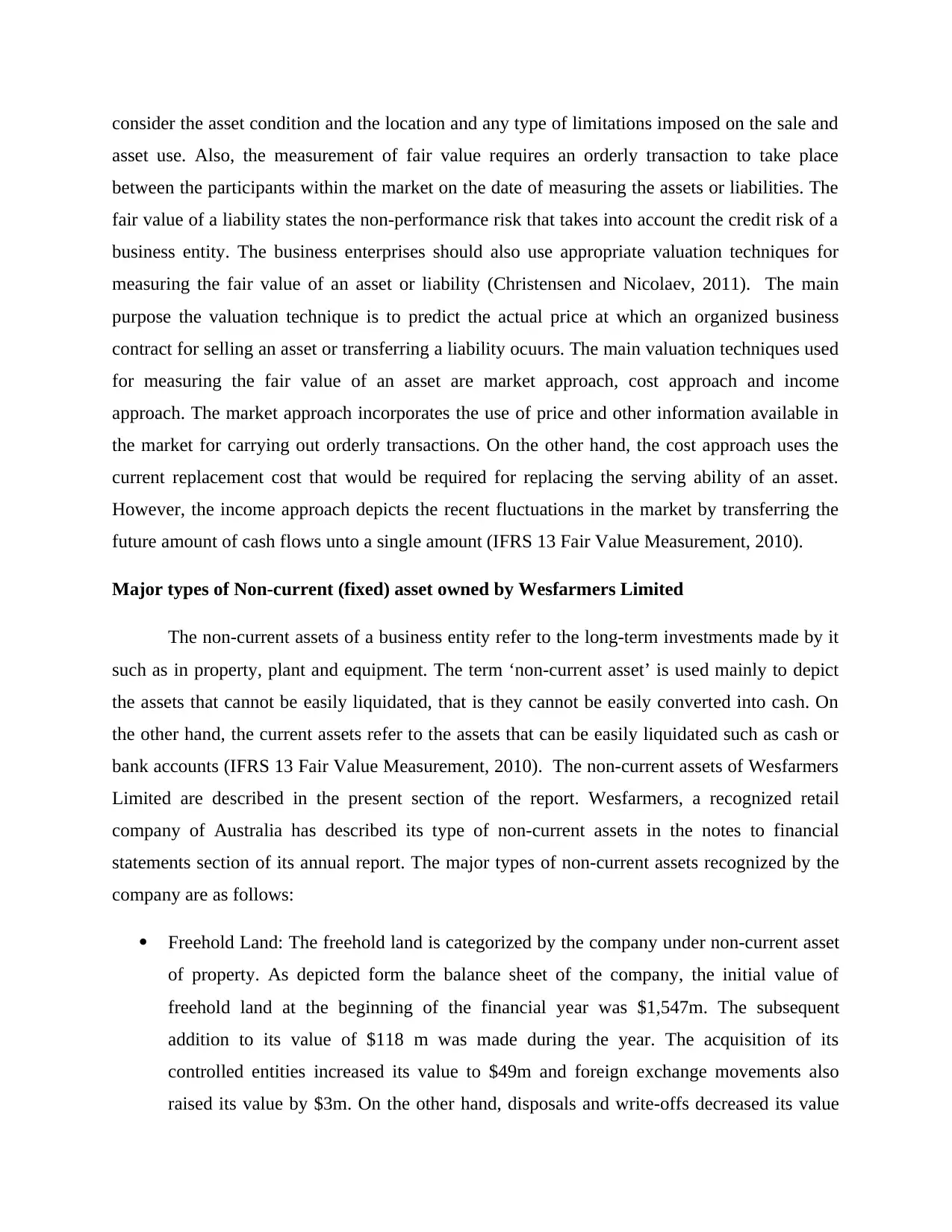
consider the asset condition and the location and any type of limitations imposed on the sale and
asset use. Also, the measurement of fair value requires an orderly transaction to take place
between the participants within the market on the date of measuring the assets or liabilities. The
fair value of a liability states the non-performance risk that takes into account the credit risk of a
business entity. The business enterprises should also use appropriate valuation techniques for
measuring the fair value of an asset or liability (Christensen and Nicolaev, 2011). The main
purpose the valuation technique is to predict the actual price at which an organized business
contract for selling an asset or transferring a liability ocuurs. The main valuation techniques used
for measuring the fair value of an asset are market approach, cost approach and income
approach. The market approach incorporates the use of price and other information available in
the market for carrying out orderly transactions. On the other hand, the cost approach uses the
current replacement cost that would be required for replacing the serving ability of an asset.
However, the income approach depicts the recent fluctuations in the market by transferring the
future amount of cash flows unto a single amount (IFRS 13 Fair Value Measurement, 2010).
Major types of Non-current (fixed) asset owned by Wesfarmers Limited
The non-current assets of a business entity refer to the long-term investments made by it
such as in property, plant and equipment. The term ‘non-current asset’ is used mainly to depict
the assets that cannot be easily liquidated, that is they cannot be easily converted into cash. On
the other hand, the current assets refer to the assets that can be easily liquidated such as cash or
bank accounts (IFRS 13 Fair Value Measurement, 2010). The non-current assets of Wesfarmers
Limited are described in the present section of the report. Wesfarmers, a recognized retail
company of Australia has described its type of non-current assets in the notes to financial
statements section of its annual report. The major types of non-current assets recognized by the
company are as follows:
Freehold Land: The freehold land is categorized by the company under non-current asset
of property. As depicted form the balance sheet of the company, the initial value of
freehold land at the beginning of the financial year was $1,547m. The subsequent
addition to its value of $118 m was made during the year. The acquisition of its
controlled entities increased its value to $49m and foreign exchange movements also
raised its value by $3m. On the other hand, disposals and write-offs decreased its value
asset use. Also, the measurement of fair value requires an orderly transaction to take place
between the participants within the market on the date of measuring the assets or liabilities. The
fair value of a liability states the non-performance risk that takes into account the credit risk of a
business entity. The business enterprises should also use appropriate valuation techniques for
measuring the fair value of an asset or liability (Christensen and Nicolaev, 2011). The main
purpose the valuation technique is to predict the actual price at which an organized business
contract for selling an asset or transferring a liability ocuurs. The main valuation techniques used
for measuring the fair value of an asset are market approach, cost approach and income
approach. The market approach incorporates the use of price and other information available in
the market for carrying out orderly transactions. On the other hand, the cost approach uses the
current replacement cost that would be required for replacing the serving ability of an asset.
However, the income approach depicts the recent fluctuations in the market by transferring the
future amount of cash flows unto a single amount (IFRS 13 Fair Value Measurement, 2010).
Major types of Non-current (fixed) asset owned by Wesfarmers Limited
The non-current assets of a business entity refer to the long-term investments made by it
such as in property, plant and equipment. The term ‘non-current asset’ is used mainly to depict
the assets that cannot be easily liquidated, that is they cannot be easily converted into cash. On
the other hand, the current assets refer to the assets that can be easily liquidated such as cash or
bank accounts (IFRS 13 Fair Value Measurement, 2010). The non-current assets of Wesfarmers
Limited are described in the present section of the report. Wesfarmers, a recognized retail
company of Australia has described its type of non-current assets in the notes to financial
statements section of its annual report. The major types of non-current assets recognized by the
company are as follows:
Freehold Land: The freehold land is categorized by the company under non-current asset
of property. As depicted form the balance sheet of the company, the initial value of
freehold land at the beginning of the financial year was $1,547m. The subsequent
addition to its value of $118 m was made during the year. The acquisition of its
controlled entities increased its value to $49m and foreign exchange movements also
raised its value by $3m. On the other hand, disposals and write-offs decreased its value
Paraphrase This Document
Need a fresh take? Get an instant paraphrase of this document with our AI Paraphraser
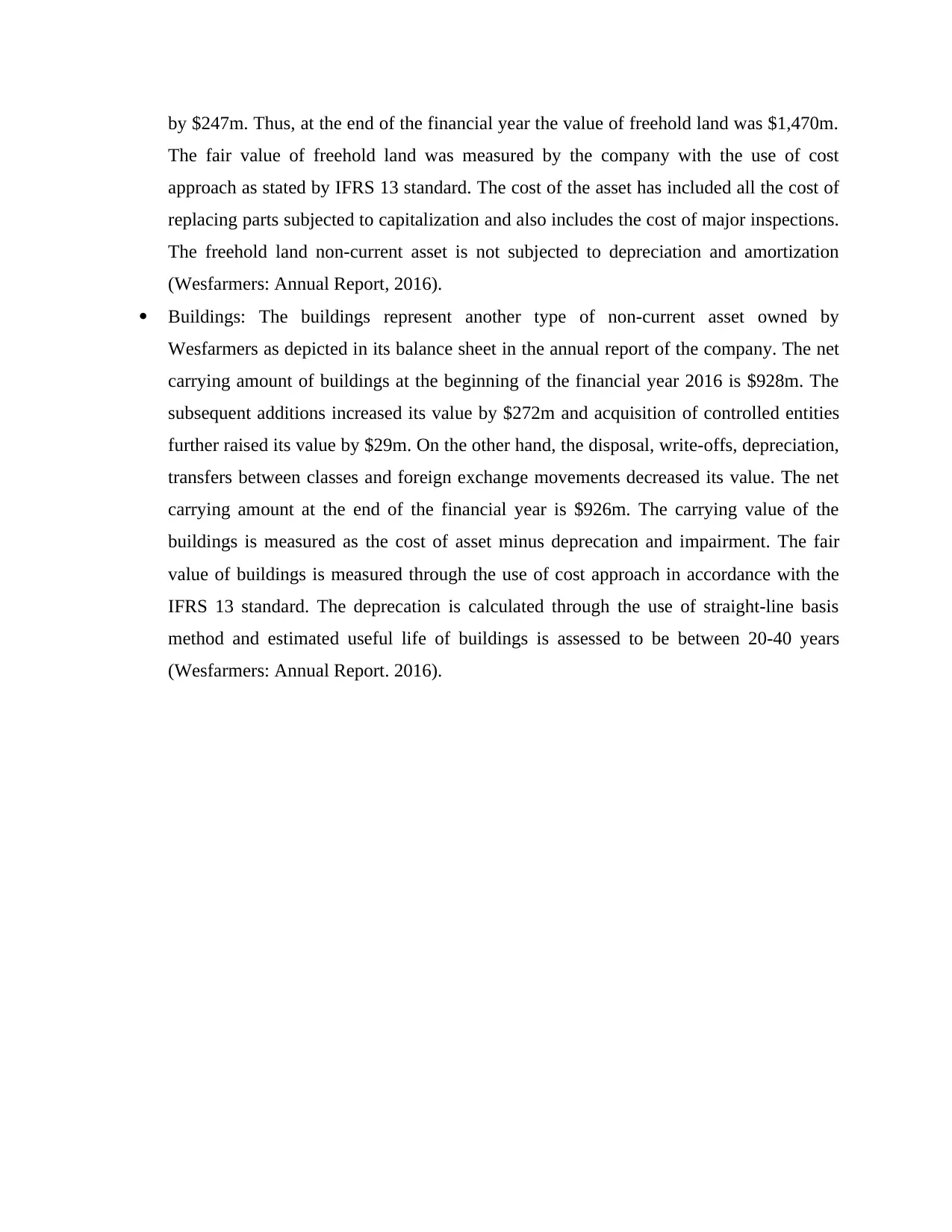
by $247m. Thus, at the end of the financial year the value of freehold land was $1,470m.
The fair value of freehold land was measured by the company with the use of cost
approach as stated by IFRS 13 standard. The cost of the asset has included all the cost of
replacing parts subjected to capitalization and also includes the cost of major inspections.
The freehold land non-current asset is not subjected to depreciation and amortization
(Wesfarmers: Annual Report, 2016).
Buildings: The buildings represent another type of non-current asset owned by
Wesfarmers as depicted in its balance sheet in the annual report of the company. The net
carrying amount of buildings at the beginning of the financial year 2016 is $928m. The
subsequent additions increased its value by $272m and acquisition of controlled entities
further raised its value by $29m. On the other hand, the disposal, write-offs, depreciation,
transfers between classes and foreign exchange movements decreased its value. The net
carrying amount at the end of the financial year is $926m. The carrying value of the
buildings is measured as the cost of asset minus deprecation and impairment. The fair
value of buildings is measured through the use of cost approach in accordance with the
IFRS 13 standard. The deprecation is calculated through the use of straight-line basis
method and estimated useful life of buildings is assessed to be between 20-40 years
(Wesfarmers: Annual Report. 2016).
The fair value of freehold land was measured by the company with the use of cost
approach as stated by IFRS 13 standard. The cost of the asset has included all the cost of
replacing parts subjected to capitalization and also includes the cost of major inspections.
The freehold land non-current asset is not subjected to depreciation and amortization
(Wesfarmers: Annual Report, 2016).
Buildings: The buildings represent another type of non-current asset owned by
Wesfarmers as depicted in its balance sheet in the annual report of the company. The net
carrying amount of buildings at the beginning of the financial year 2016 is $928m. The
subsequent additions increased its value by $272m and acquisition of controlled entities
further raised its value by $29m. On the other hand, the disposal, write-offs, depreciation,
transfers between classes and foreign exchange movements decreased its value. The net
carrying amount at the end of the financial year is $926m. The carrying value of the
buildings is measured as the cost of asset minus deprecation and impairment. The fair
value of buildings is measured through the use of cost approach in accordance with the
IFRS 13 standard. The deprecation is calculated through the use of straight-line basis
method and estimated useful life of buildings is assessed to be between 20-40 years
(Wesfarmers: Annual Report. 2016).
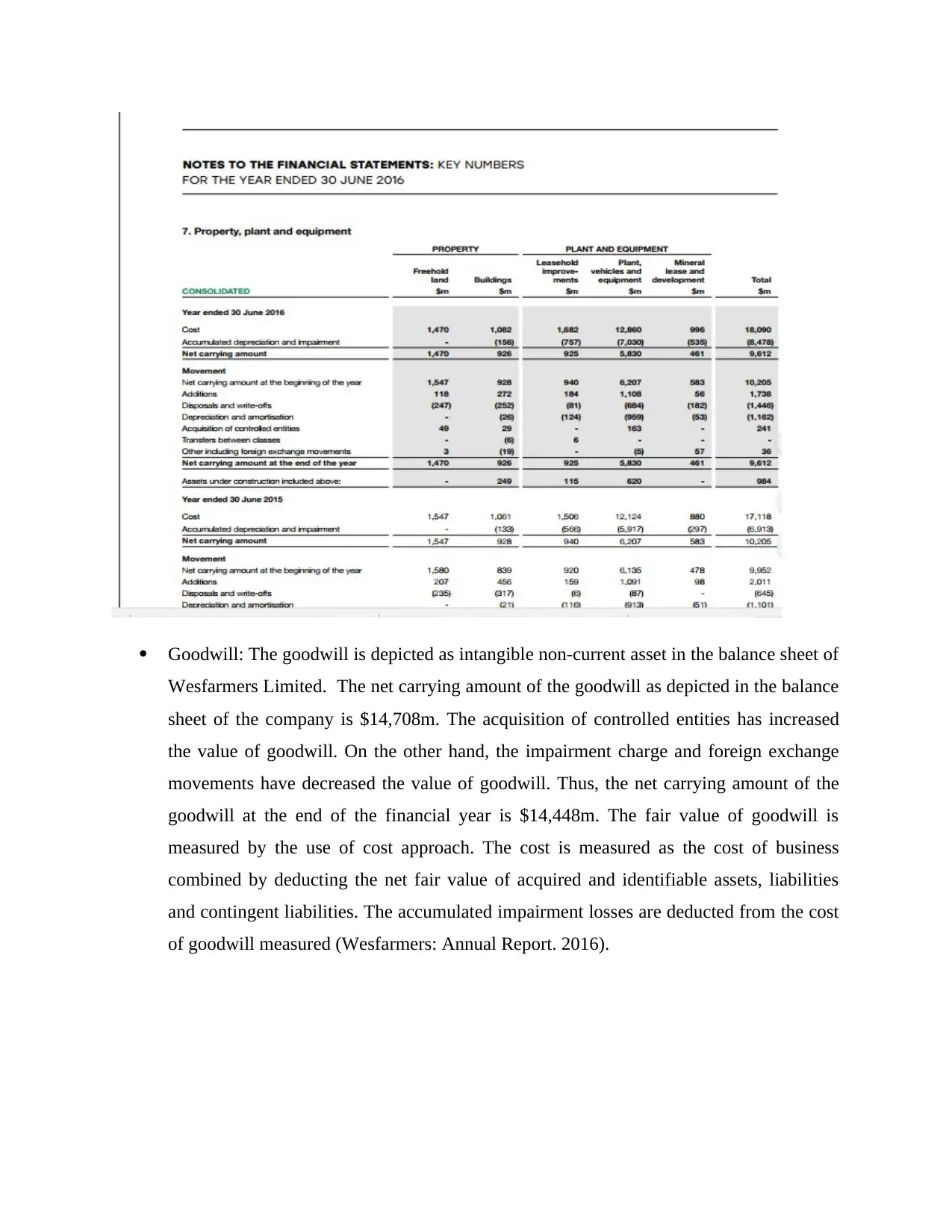
Goodwill: The goodwill is depicted as intangible non-current asset in the balance sheet of
Wesfarmers Limited. The net carrying amount of the goodwill as depicted in the balance
sheet of the company is $14,708m. The acquisition of controlled entities has increased
the value of goodwill. On the other hand, the impairment charge and foreign exchange
movements have decreased the value of goodwill. Thus, the net carrying amount of the
goodwill at the end of the financial year is $14,448m. The fair value of goodwill is
measured by the use of cost approach. The cost is measured as the cost of business
combined by deducting the net fair value of acquired and identifiable assets, liabilities
and contingent liabilities. The accumulated impairment losses are deducted from the cost
of goodwill measured (Wesfarmers: Annual Report. 2016).
Wesfarmers Limited. The net carrying amount of the goodwill as depicted in the balance
sheet of the company is $14,708m. The acquisition of controlled entities has increased
the value of goodwill. On the other hand, the impairment charge and foreign exchange
movements have decreased the value of goodwill. Thus, the net carrying amount of the
goodwill at the end of the financial year is $14,448m. The fair value of goodwill is
measured by the use of cost approach. The cost is measured as the cost of business
combined by deducting the net fair value of acquired and identifiable assets, liabilities
and contingent liabilities. The accumulated impairment losses are deducted from the cost
of goodwill measured (Wesfarmers: Annual Report. 2016).
⊘ This is a preview!⊘
Do you want full access?
Subscribe today to unlock all pages.

Trusted by 1+ million students worldwide
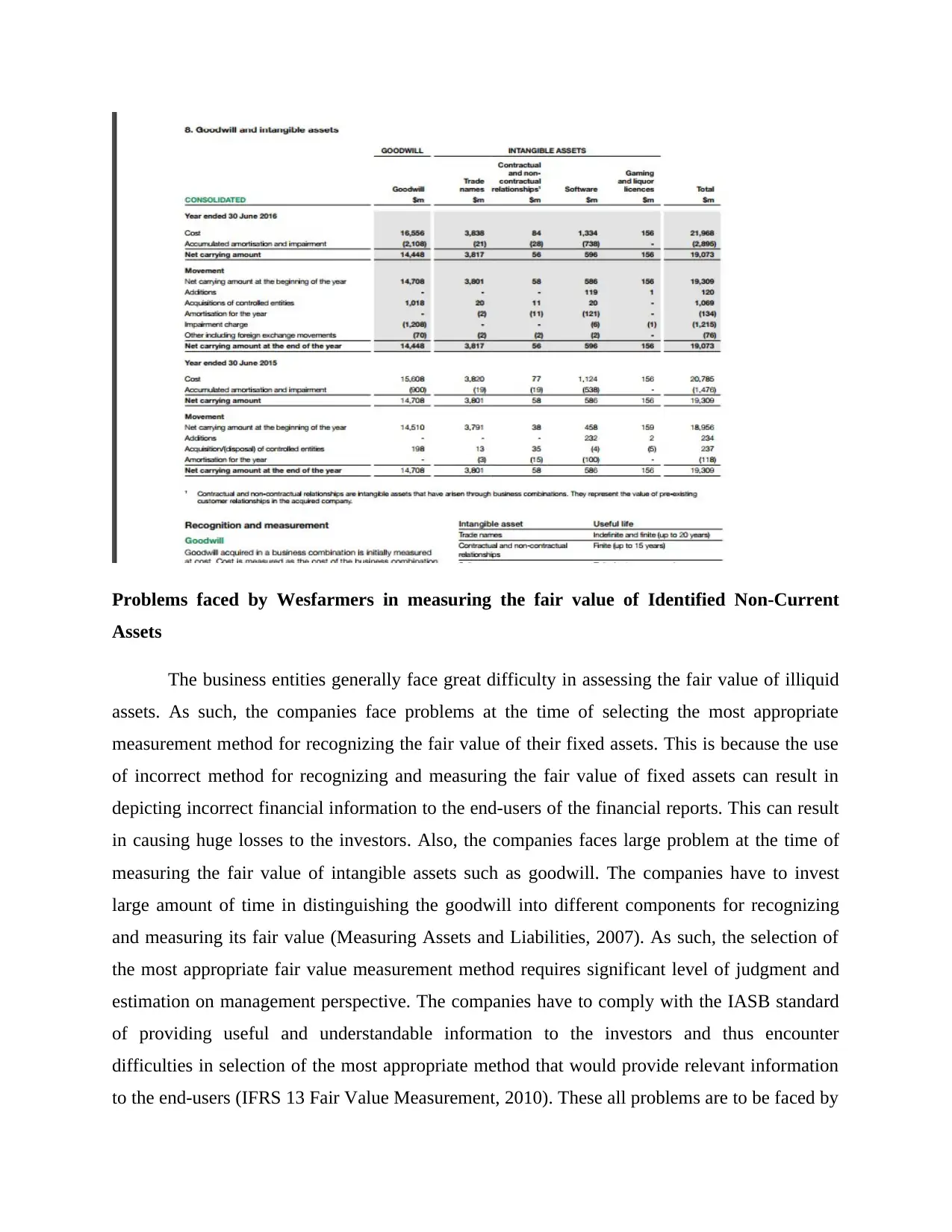
Problems faced by Wesfarmers in measuring the fair value of Identified Non-Current
Assets
The business entities generally face great difficulty in assessing the fair value of illiquid
assets. As such, the companies face problems at the time of selecting the most appropriate
measurement method for recognizing the fair value of their fixed assets. This is because the use
of incorrect method for recognizing and measuring the fair value of fixed assets can result in
depicting incorrect financial information to the end-users of the financial reports. This can result
in causing huge losses to the investors. Also, the companies faces large problem at the time of
measuring the fair value of intangible assets such as goodwill. The companies have to invest
large amount of time in distinguishing the goodwill into different components for recognizing
and measuring its fair value (Measuring Assets and Liabilities, 2007). As such, the selection of
the most appropriate fair value measurement method requires significant level of judgment and
estimation on management perspective. The companies have to comply with the IASB standard
of providing useful and understandable information to the investors and thus encounter
difficulties in selection of the most appropriate method that would provide relevant information
to the end-users (IFRS 13 Fair Value Measurement, 2010). These all problems are to be faced by
Assets
The business entities generally face great difficulty in assessing the fair value of illiquid
assets. As such, the companies face problems at the time of selecting the most appropriate
measurement method for recognizing the fair value of their fixed assets. This is because the use
of incorrect method for recognizing and measuring the fair value of fixed assets can result in
depicting incorrect financial information to the end-users of the financial reports. This can result
in causing huge losses to the investors. Also, the companies faces large problem at the time of
measuring the fair value of intangible assets such as goodwill. The companies have to invest
large amount of time in distinguishing the goodwill into different components for recognizing
and measuring its fair value (Measuring Assets and Liabilities, 2007). As such, the selection of
the most appropriate fair value measurement method requires significant level of judgment and
estimation on management perspective. The companies have to comply with the IASB standard
of providing useful and understandable information to the investors and thus encounter
difficulties in selection of the most appropriate method that would provide relevant information
to the end-users (IFRS 13 Fair Value Measurement, 2010). These all problems are to be faced by
Paraphrase This Document
Need a fresh take? Get an instant paraphrase of this document with our AI Paraphraser
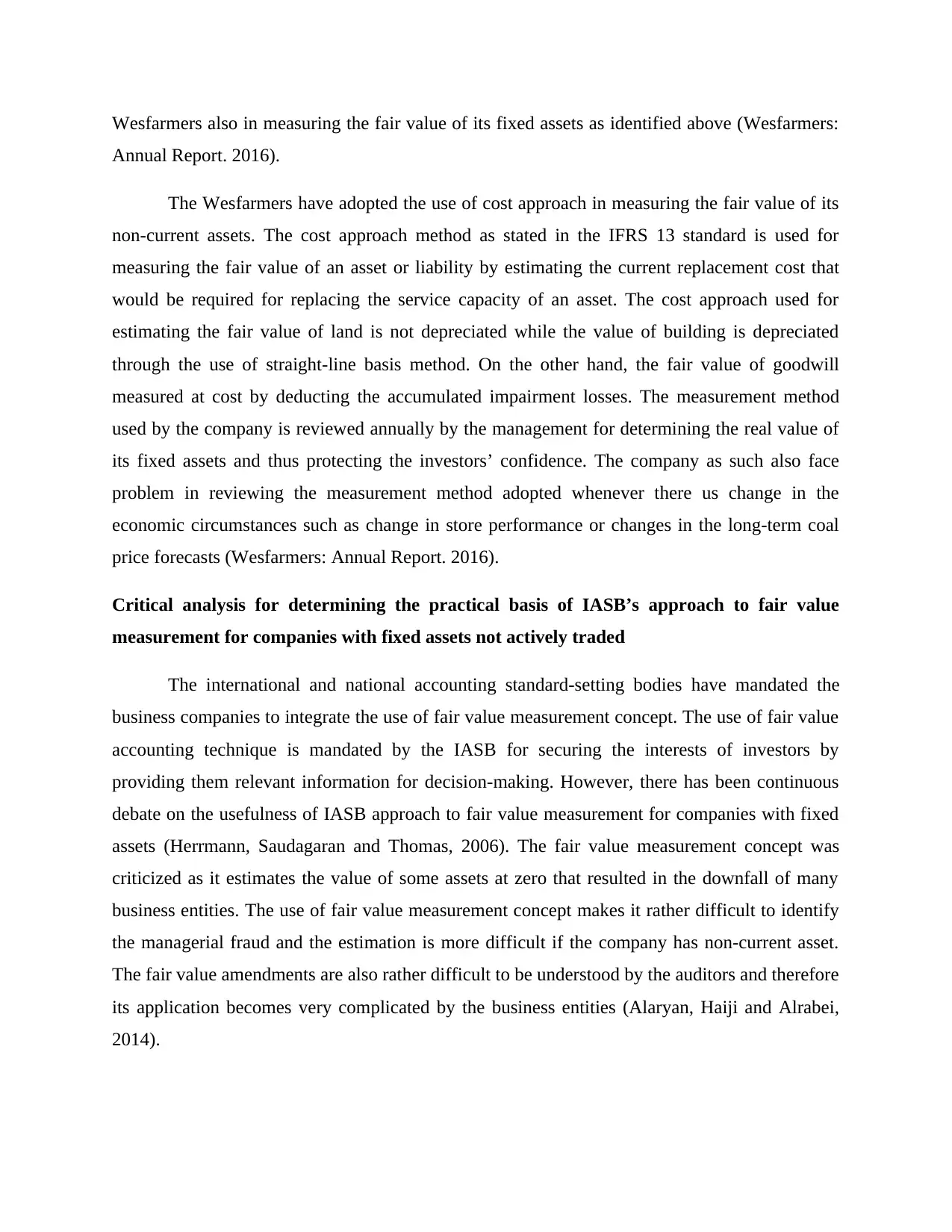
Wesfarmers also in measuring the fair value of its fixed assets as identified above (Wesfarmers:
Annual Report. 2016).
The Wesfarmers have adopted the use of cost approach in measuring the fair value of its
non-current assets. The cost approach method as stated in the IFRS 13 standard is used for
measuring the fair value of an asset or liability by estimating the current replacement cost that
would be required for replacing the service capacity of an asset. The cost approach used for
estimating the fair value of land is not depreciated while the value of building is depreciated
through the use of straight-line basis method. On the other hand, the fair value of goodwill
measured at cost by deducting the accumulated impairment losses. The measurement method
used by the company is reviewed annually by the management for determining the real value of
its fixed assets and thus protecting the investors’ confidence. The company as such also face
problem in reviewing the measurement method adopted whenever there us change in the
economic circumstances such as change in store performance or changes in the long-term coal
price forecasts (Wesfarmers: Annual Report. 2016).
Critical analysis for determining the practical basis of IASB’s approach to fair value
measurement for companies with fixed assets not actively traded
The international and national accounting standard-setting bodies have mandated the
business companies to integrate the use of fair value measurement concept. The use of fair value
accounting technique is mandated by the IASB for securing the interests of investors by
providing them relevant information for decision-making. However, there has been continuous
debate on the usefulness of IASB approach to fair value measurement for companies with fixed
assets (Herrmann, Saudagaran and Thomas, 2006). The fair value measurement concept was
criticized as it estimates the value of some assets at zero that resulted in the downfall of many
business entities. The use of fair value measurement concept makes it rather difficult to identify
the managerial fraud and the estimation is more difficult if the company has non-current asset.
The fair value amendments are also rather difficult to be understood by the auditors and therefore
its application becomes very complicated by the business entities (Alaryan, Haiji and Alrabei,
2014).
Annual Report. 2016).
The Wesfarmers have adopted the use of cost approach in measuring the fair value of its
non-current assets. The cost approach method as stated in the IFRS 13 standard is used for
measuring the fair value of an asset or liability by estimating the current replacement cost that
would be required for replacing the service capacity of an asset. The cost approach used for
estimating the fair value of land is not depreciated while the value of building is depreciated
through the use of straight-line basis method. On the other hand, the fair value of goodwill
measured at cost by deducting the accumulated impairment losses. The measurement method
used by the company is reviewed annually by the management for determining the real value of
its fixed assets and thus protecting the investors’ confidence. The company as such also face
problem in reviewing the measurement method adopted whenever there us change in the
economic circumstances such as change in store performance or changes in the long-term coal
price forecasts (Wesfarmers: Annual Report. 2016).
Critical analysis for determining the practical basis of IASB’s approach to fair value
measurement for companies with fixed assets not actively traded
The international and national accounting standard-setting bodies have mandated the
business companies to integrate the use of fair value measurement concept. The use of fair value
accounting technique is mandated by the IASB for securing the interests of investors by
providing them relevant information for decision-making. However, there has been continuous
debate on the usefulness of IASB approach to fair value measurement for companies with fixed
assets (Herrmann, Saudagaran and Thomas, 2006). The fair value measurement concept was
criticized as it estimates the value of some assets at zero that resulted in the downfall of many
business entities. The use of fair value measurement concept makes it rather difficult to identify
the managerial fraud and the estimation is more difficult if the company has non-current asset.
The fair value amendments are also rather difficult to be understood by the auditors and therefore
its application becomes very complicated by the business entities (Alaryan, Haiji and Alrabei,
2014).
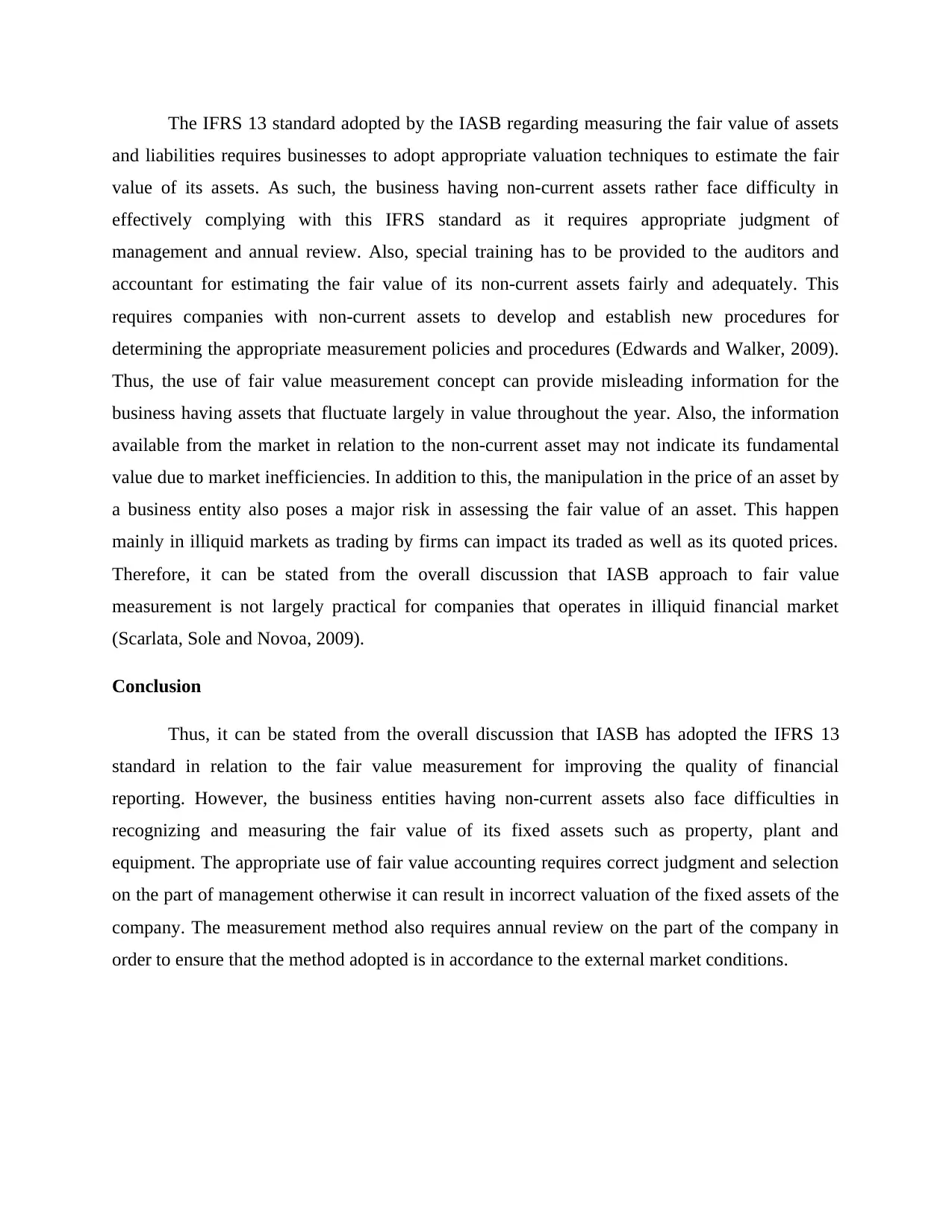
The IFRS 13 standard adopted by the IASB regarding measuring the fair value of assets
and liabilities requires businesses to adopt appropriate valuation techniques to estimate the fair
value of its assets. As such, the business having non-current assets rather face difficulty in
effectively complying with this IFRS standard as it requires appropriate judgment of
management and annual review. Also, special training has to be provided to the auditors and
accountant for estimating the fair value of its non-current assets fairly and adequately. This
requires companies with non-current assets to develop and establish new procedures for
determining the appropriate measurement policies and procedures (Edwards and Walker, 2009).
Thus, the use of fair value measurement concept can provide misleading information for the
business having assets that fluctuate largely in value throughout the year. Also, the information
available from the market in relation to the non-current asset may not indicate its fundamental
value due to market inefficiencies. In addition to this, the manipulation in the price of an asset by
a business entity also poses a major risk in assessing the fair value of an asset. This happen
mainly in illiquid markets as trading by firms can impact its traded as well as its quoted prices.
Therefore, it can be stated from the overall discussion that IASB approach to fair value
measurement is not largely practical for companies that operates in illiquid financial market
(Scarlata, Sole and Novoa, 2009).
Conclusion
Thus, it can be stated from the overall discussion that IASB has adopted the IFRS 13
standard in relation to the fair value measurement for improving the quality of financial
reporting. However, the business entities having non-current assets also face difficulties in
recognizing and measuring the fair value of its fixed assets such as property, plant and
equipment. The appropriate use of fair value accounting requires correct judgment and selection
on the part of management otherwise it can result in incorrect valuation of the fixed assets of the
company. The measurement method also requires annual review on the part of the company in
order to ensure that the method adopted is in accordance to the external market conditions.
and liabilities requires businesses to adopt appropriate valuation techniques to estimate the fair
value of its assets. As such, the business having non-current assets rather face difficulty in
effectively complying with this IFRS standard as it requires appropriate judgment of
management and annual review. Also, special training has to be provided to the auditors and
accountant for estimating the fair value of its non-current assets fairly and adequately. This
requires companies with non-current assets to develop and establish new procedures for
determining the appropriate measurement policies and procedures (Edwards and Walker, 2009).
Thus, the use of fair value measurement concept can provide misleading information for the
business having assets that fluctuate largely in value throughout the year. Also, the information
available from the market in relation to the non-current asset may not indicate its fundamental
value due to market inefficiencies. In addition to this, the manipulation in the price of an asset by
a business entity also poses a major risk in assessing the fair value of an asset. This happen
mainly in illiquid markets as trading by firms can impact its traded as well as its quoted prices.
Therefore, it can be stated from the overall discussion that IASB approach to fair value
measurement is not largely practical for companies that operates in illiquid financial market
(Scarlata, Sole and Novoa, 2009).
Conclusion
Thus, it can be stated from the overall discussion that IASB has adopted the IFRS 13
standard in relation to the fair value measurement for improving the quality of financial
reporting. However, the business entities having non-current assets also face difficulties in
recognizing and measuring the fair value of its fixed assets such as property, plant and
equipment. The appropriate use of fair value accounting requires correct judgment and selection
on the part of management otherwise it can result in incorrect valuation of the fixed assets of the
company. The measurement method also requires annual review on the part of the company in
order to ensure that the method adopted is in accordance to the external market conditions.
⊘ This is a preview!⊘
Do you want full access?
Subscribe today to unlock all pages.

Trusted by 1+ million students worldwide
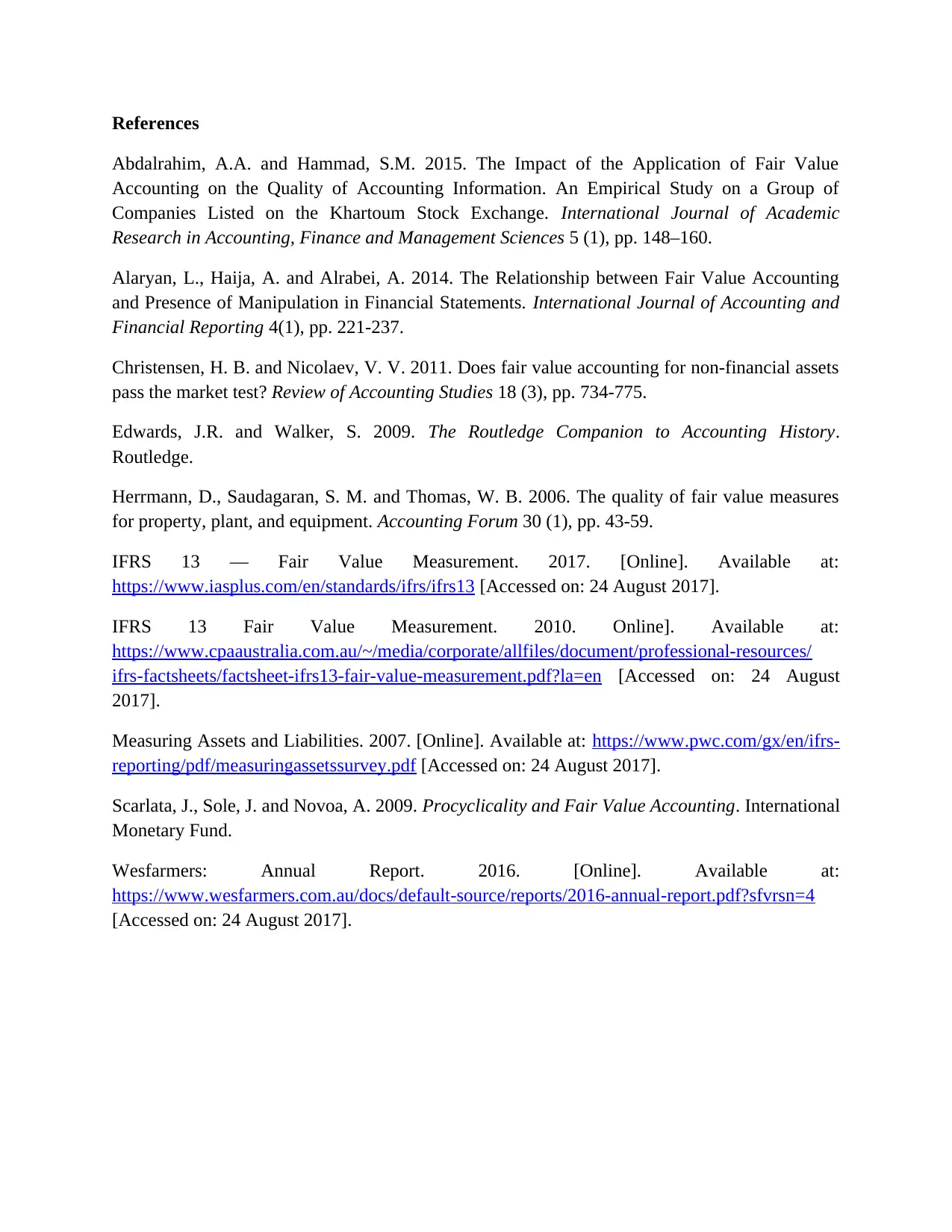
References
Abdalrahim, A.A. and Hammad, S.M. 2015. The Impact of the Application of Fair Value
Accounting on the Quality of Accounting Information. An Empirical Study on a Group of
Companies Listed on the Khartoum Stock Exchange. International Journal of Academic
Research in Accounting, Finance and Management Sciences 5 (1), pp. 148–160.
Alaryan, L., Haija, A. and Alrabei, A. 2014. The Relationship between Fair Value Accounting
and Presence of Manipulation in Financial Statements. International Journal of Accounting and
Financial Reporting 4(1), pp. 221-237.
Christensen, H. B. and Nicolaev, V. V. 2011. Does fair value accounting for non-financial assets
pass the market test? Review of Accounting Studies 18 (3), pp. 734-775.
Edwards, J.R. and Walker, S. 2009. The Routledge Companion to Accounting History.
Routledge.
Herrmann, D., Saudagaran, S. M. and Thomas, W. B. 2006. The quality of fair value measures
for property, plant, and equipment. Accounting Forum 30 (1), pp. 43-59.
IFRS 13 — Fair Value Measurement. 2017. [Online]. Available at:
https://www.iasplus.com/en/standards/ifrs/ifrs13 [Accessed on: 24 August 2017].
IFRS 13 Fair Value Measurement. 2010. Online]. Available at:
https://www.cpaaustralia.com.au/~/media/corporate/allfiles/document/professional-resources/
ifrs-factsheets/factsheet-ifrs13-fair-value-measurement.pdf?la=en [Accessed on: 24 August
2017].
Measuring Assets and Liabilities. 2007. [Online]. Available at: https://www.pwc.com/gx/en/ifrs-
reporting/pdf/measuringassetssurvey.pdf [Accessed on: 24 August 2017].
Scarlata, J., Sole, J. and Novoa, A. 2009. Procyclicality and Fair Value Accounting. International
Monetary Fund.
Wesfarmers: Annual Report. 2016. [Online]. Available at:
https://www.wesfarmers.com.au/docs/default-source/reports/2016-annual-report.pdf?sfvrsn=4
[Accessed on: 24 August 2017].
Abdalrahim, A.A. and Hammad, S.M. 2015. The Impact of the Application of Fair Value
Accounting on the Quality of Accounting Information. An Empirical Study on a Group of
Companies Listed on the Khartoum Stock Exchange. International Journal of Academic
Research in Accounting, Finance and Management Sciences 5 (1), pp. 148–160.
Alaryan, L., Haija, A. and Alrabei, A. 2014. The Relationship between Fair Value Accounting
and Presence of Manipulation in Financial Statements. International Journal of Accounting and
Financial Reporting 4(1), pp. 221-237.
Christensen, H. B. and Nicolaev, V. V. 2011. Does fair value accounting for non-financial assets
pass the market test? Review of Accounting Studies 18 (3), pp. 734-775.
Edwards, J.R. and Walker, S. 2009. The Routledge Companion to Accounting History.
Routledge.
Herrmann, D., Saudagaran, S. M. and Thomas, W. B. 2006. The quality of fair value measures
for property, plant, and equipment. Accounting Forum 30 (1), pp. 43-59.
IFRS 13 — Fair Value Measurement. 2017. [Online]. Available at:
https://www.iasplus.com/en/standards/ifrs/ifrs13 [Accessed on: 24 August 2017].
IFRS 13 Fair Value Measurement. 2010. Online]. Available at:
https://www.cpaaustralia.com.au/~/media/corporate/allfiles/document/professional-resources/
ifrs-factsheets/factsheet-ifrs13-fair-value-measurement.pdf?la=en [Accessed on: 24 August
2017].
Measuring Assets and Liabilities. 2007. [Online]. Available at: https://www.pwc.com/gx/en/ifrs-
reporting/pdf/measuringassetssurvey.pdf [Accessed on: 24 August 2017].
Scarlata, J., Sole, J. and Novoa, A. 2009. Procyclicality and Fair Value Accounting. International
Monetary Fund.
Wesfarmers: Annual Report. 2016. [Online]. Available at:
https://www.wesfarmers.com.au/docs/default-source/reports/2016-annual-report.pdf?sfvrsn=4
[Accessed on: 24 August 2017].
1 out of 10
Related Documents
Your All-in-One AI-Powered Toolkit for Academic Success.
+13062052269
info@desklib.com
Available 24*7 on WhatsApp / Email
![[object Object]](/_next/static/media/star-bottom.7253800d.svg)
Unlock your academic potential
Copyright © 2020–2025 A2Z Services. All Rights Reserved. Developed and managed by ZUCOL.





